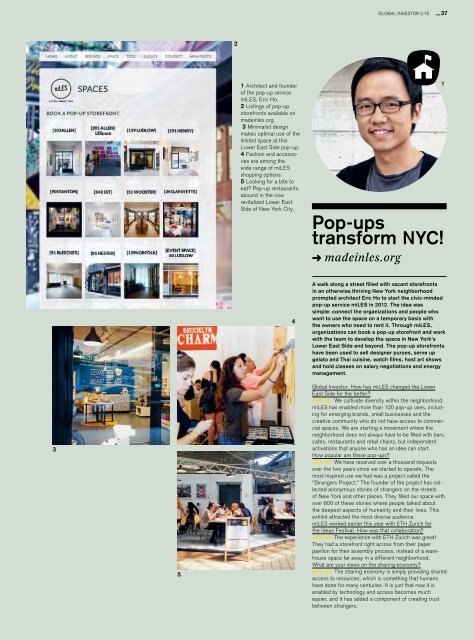The sharing economy
New opportunities, new questions Global Investor, 02/2015 Credit Suisse
New opportunities, new questions
Global Investor, 02/2015
Credit Suisse
Create successful ePaper yourself
Turn your PDF publications into a flip-book with our unique Google optimized e-Paper software.
GLOBAL INVESTOR 2.15 — 37<br />
2<br />
1 Architect and founder<br />
of the pop-up service<br />
miLES, Eric Ho.<br />
2 Listings of pop-up<br />
storefronts available on<br />
madeinles.org<br />
3 Minimalist design<br />
makes optimal use of the<br />
limited space at this<br />
Lower East Side pop-up.<br />
4 Fashion and accessories<br />
are among the<br />
wide range of miLES<br />
shopping options.<br />
5 Looking for a bite to<br />
eat? Pop-up restaurants<br />
abound in the now<br />
revitalized Lower East<br />
Side of New York City.<br />
Pop-ups<br />
transform NYC!<br />
madeinles.org<br />
1<br />
4<br />
A walk along a street filled with vacant storefronts<br />
in an otherwise thriving New York neighborhood<br />
prompted architect Eric Ho to start the civic-minded<br />
pop-up service miLES in 2012. <strong>The</strong> idea was<br />
simple: connect the organizations and people who<br />
want to use the space on a temporary basis with<br />
the owners who need to rent it. Through miLES,<br />
organizations can book a pop-up storefront and work<br />
with the team to develop the space in New York’s<br />
Lower East Side and beyond. <strong>The</strong> pop-up storefronts<br />
have been used to sell designer purses, serve up<br />
gelato and Thai cuisine, watch films, host art shows<br />
and hold classes on salary negotiations and energy<br />
management.<br />
3<br />
5<br />
Global Investor: How has miLES changed the Lower<br />
East Side for the better?<br />
ERIC HO: We cultivate diversity within the neighborhood.<br />
miLES has enabled more than 100 pop-up uses, including<br />
for emerging brands, small businesses and the<br />
creative community who do not have access to commercial<br />
spaces. We are starting a movement where the<br />
neighborhood does not always have to be filled with bars,<br />
cafes, restaurants and retail chains, but independent<br />
activations that anyone who has an idea can start.<br />
How popular are these pop-ups?<br />
ERIC HO: We have received over a thousand requests<br />
over the two years since we started to operate. <strong>The</strong><br />
most inspired use we had was a project called the<br />
“Strangers Project.” <strong>The</strong> founder of the project has collected<br />
anonymous stories of strangers on the streets<br />
of New York and other places. <strong>The</strong>y filled our space with<br />
over 600 of these stories where people talked about<br />
the deepest aspects of humanity and their lives. This<br />
exhibit attracted the most diverse audience.<br />
miLES worked earlier this year with ETH Zurich for<br />
the Ideas Festival. How was that collaboration?<br />
ERIC HO: <strong>The</strong> experience with ETH Zurich was great!<br />
<strong>The</strong>y had a storefront right across from their paper<br />
pavilion for their assembly process, instead of a warehouse<br />
space far away in a different neighborhood.<br />
What are your views on the <strong>sharing</strong> <strong>economy</strong>?<br />
ERIC HO: <strong>The</strong> <strong>sharing</strong> <strong>economy</strong> is simply providing shared<br />
access to resources, which is something that humans<br />
have done for many centuries. It is just that now it is<br />
enabled by technology and access becomes much<br />
easier, and it has added a component of creating trust<br />
between strangers.

















